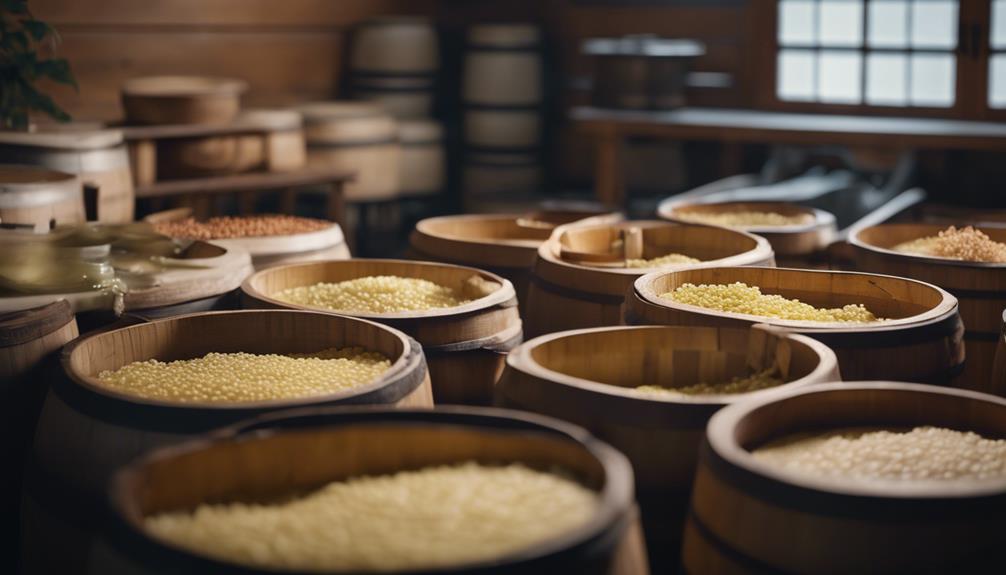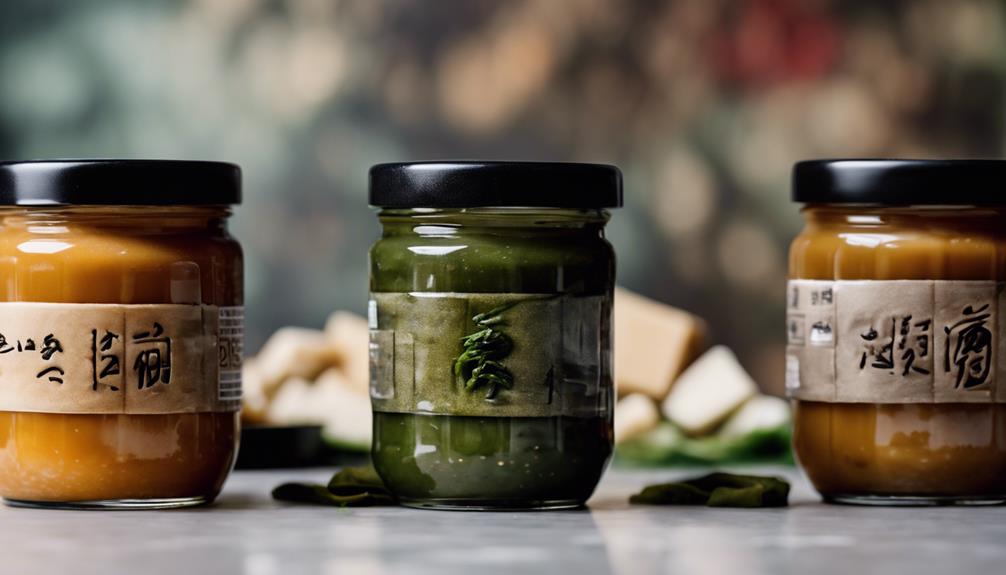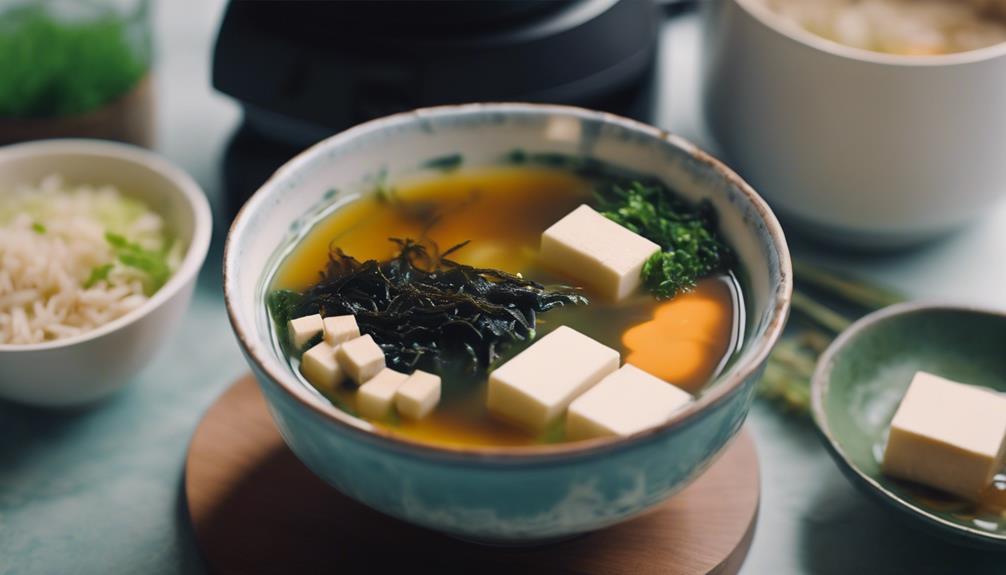Sous Vide Miso Soup With Seaweed and Tofu
Immerse yourself in the exquisite blend of savory miso, nutrient-rich seaweed, and delicate tofu cooked precisely with sous vide. This modern take on classic miso soup delivers a flavorful, healthful dish. The meticulous temperature control guarantees every ingredient harmonizes, creating a rich and customized taste. Benefit from the probiotic richness of the miso paste and the symphony of flavors the sesame oil brings. Enhance the umami notes in your soup and savor the seamless fusion of ingredients. Uncover more about miso paste varieties, tofu and seaweed combinations, and creative garnish ideas to elevate your sous vide miso soup experience.
What You Will Learn Here
- Sous vide method ensures precise temperature control for optimal umami development.
- Incorporates nutrient-rich seaweed and tofu for added texture and flavor complexity.
- Utilizes miso paste for its probiotic benefits and rich umami taste.
- Offers a modern twist on traditional miso soup with customizable flavors.
- Combination of ingredients results in a harmonious, flavorful, and nutrient-dense soup.
Miso Paste Fermentation Origins

Miso paste fermentation, originating in China and introduced to Japan centuries ago, plays an essential role in the creation of this savory condiment. Understanding the historical roots of miso sheds light on its significance in Japanese cuisine.
Additionally, delving into the health benefits of miso highlights its value beyond just being a flavorful addition to dishes.
Miso Paste Fermentation Process
The ancient roots of miso paste fermentation can be traced back to China, where the process was first developed before making its way to Japan over 1,300 years ago through the teachings of Buddhist priests.
In the fermentation process, a mixture of salt, grains, and soybeans is carefully combined to create miso paste, allowing for preservation and flavor development.
The unique variations of miso paste found across different regions in Japan, such as rice miso, sweet white miso, soy miso, and barley miso, showcase the diversity in fermentation techniques and ingredients used.
This process results in a nutrient-rich product, abundant in minerals like zinc, copper, manganese, B vitamins, vitamin K, and antioxidants, while also fostering the growth of beneficial bacteria essential for gut health.
Historical Origins of Miso
Originating in ancient China and brought to Japan over 1,300 years ago by Buddhist priests, the fermentation process for miso paste combines salt, grains, and soybeans to create a flavorful and nutrient-rich product. Miso paste has a deep-rooted history in Japanese cuisine, evolving into various regional varieties like rice miso in the north and barley miso in the south. The fermentation of miso paste not only preserves the ingredients but also enhances their umami flavors, making it a staple in traditional Japanese dishes like miso soup. The rich mineral content of miso paste, including zinc, copper, B vitamins, and phytonutrient antioxidants, adds to its appeal as a healthful and versatile ingredient.
| Miso Paste | Fermentation | Japan |
|---|---|---|
| Salt, grains | Preservation | Varieties |
| Umami flavor | Nutrient-rich | Traditional cuisine |
| Minerals | Antioxidants | Regional influences |
Health Benefits of Miso
Centuries ago, the introduction of miso paste from China to Japan by Buddhist priests laid the foundation for a culinary tradition rich in health benefits and complex flavors. Miso, a fermented mixture of soybeans, salt, and grains, offers a plethora of advantages. This paste contains beneficial bacteria important for gut health and is a potent source of minerals like zinc, copper, and B vitamins.
Incorporating tofu, another soy-based product rich in plant-based proteins, into dishes like miso soup further enhances the nutritional profile. The various types of miso, such as rice miso, sweet white miso, soy miso, and barley miso, each bring distinct flavors and health benefits to the table. Embracing miso in your diet can be a flavorful journey towards better health.
Miso Paste Varieties

When exploring miso paste varieties, you encounter a diverse range of flavors and textures that can elevate your culinary creations. Each type of miso paste brings a unique taste profile to your dishes, enhancing the depth of flavors in your recipes.
Here are three key varieties worth exploring:
- White Miso: Also known as shiro miso, this type of miso paste is characterized by its sweet and mild flavor. White miso is commonly used in light soups and dressings, adding a subtle complexity to the dish without overpowering other ingredients.
- Red Miso: Red miso, or aka miso, offers a stronger and saltier taste compared to white miso. Its robust flavor profile makes it ideal for hearty dishes and marinades, where it can stand out and complement rich ingredients.
- Barley Miso: Made with barley koji, barley miso provides a nutty and rich flavor that works well in stews and braised dishes. The barley adds a depth of umami flavor, creating a savory base for your culinary creations.
Tofu and Seaweed Combinations
When combining tofu and seaweed in miso soup, you create a dynamic duo that offers a blend of textures and flavors.
The creamy tofu complements the savory umami taste of seaweed, resulting in a well-rounded dish.
This combination not only enhances the soup's taste but also provides a nutritious boost, making it a satisfying and healthy choice.
Quick Miso Soup With Tofu
For a quick and satisfying miso soup with tofu bursting with umami flavors, consider adding in cubes of tofu and nutrient-rich seaweed to create a harmonious balance of textures and tastes. When preparing this quick miso soup, the combination of tofu and seaweed offers a delightful interplay of creaminess and oceanic freshness that elevates the dish to a new level. Here's why this duo of tofu and seaweed in miso soup is a winning combination:
- Plant-Based Protein: Tofu in miso soup provides a healthy dose of plant-based protein, making this dish a nutritious option.
- Essential Minerals: Seaweed, like Wakame, enriches the soup with essential minerals like iodine, calcium, and iron for added health benefits.
- Balanced Flavor Profile: The marriage of savory miso, silky tofu, and briny seaweed creates a well-rounded flavor profile that's both comforting and nourishing.
Tofu and Mushroom Stir-Fry
Combining tofu and mushrooms in a stir-fry creates a delectable fusion of earthy flavors and protein-rich textures that elevate the dish to a satisfying and nutritious meal option. Here are three reasons why this tofu and mushroom stir-fry is a must-try:
- Versatility: You can experiment with different types of mushrooms like Shiitake, cremini, or oyster mushrooms to create varying depths of flavors in your dish.
- Protein Powerhouse: The combination of tofu and mushrooms offers a good source of plant-based protein, making it a satisfying meal choice.
- Savory Absorption: Stir-frying tofu and sliced mushrooms together allows them to soak up the delicious flavors of the sauces or seasonings, enhancing the overall taste experience.
This stir-fry isn't only quick and easy but also a delightful vegetarian or vegan option that can be enjoyed as a main or side dish.
Tofu and Daikon Miso Combination
Enhancing the umami richness of miso soup, the combination of tofu and daikon offers a harmonious blend of textures and flavors that elevate this traditional Japanese dish to a comforting and nutritious delight.
The daikon adds a subtle sweetness and crunch, complementing the savory miso and soft tofu perfectly. Tofu, known for its ability to absorb flavors, enhances the protein content of the dish while soaking up the rich miso broth.
When combined, daikon and tofu create a hearty and satisfying meal, ideal for a warm bowl of soup on any day. This traditional Japanese pairing not only provides a nutritious meal but also introduces a delicious way to enjoy miso soup with added depth and complexity.
Miso Soup Garnish Ideas
Enhance the flavors of your miso soup by exploring various garnish options like:
- Green onions
- Sesame seeds
- Shichimi togarashi
Experiment with tofu variations for garnishing to add different textures and protein sources to your soup.
Consider seaweed pairing suggestions to complement the umami-rich miso base and elevate the overall taste experience.
Garnish Options for Miso
For a vibrant and flavorful finishing touch to your miso soup, consider enhancing it with an array of garnish options that range from sliced green onions to crispy fried shallots.
Sliced green onions add a fresh, mild onion flavor and a pop of color to your miso soup. Toasted sesame seeds bring a nutty crunch and a hint of smokiness that complements the earthy miso broth.
These traditional garnishes can be elevated with additions like shredded nori seaweed for a taste of the ocean or diced avocado for a creamy texture. Experimenting with unique toppings such as furikake seasoning or a drizzle of chili oil can take your miso soup to new heights of flavor and creativity.
Tofu Variations for Garnish
To elevate your miso soup with a variety of textures and flavors, consider exploring different tofu variations as garnishes. Firm tofu, when cubed and fried until crispy, can add a delightful crunch and depth to your soup.
Silken tofu, sliced thinly, brings a creamy contrast that complements the rich miso broth perfectly. For those looking to enhance the flavors further, marinated tofu pieces are an excellent choice, infusing the soup with additional layers of taste.
Each tofu variation offers a unique twist to your miso soup, allowing you to customize your dish to suit your preferences. Experimenting with different tofu types like firm, silken, and marinated can elevate your miso soup to a whole new level of deliciousness.
Seaweed Pairing Suggestions
Considering the diverse textures and flavors tofu can bring to your miso soup, exploring seaweed pairing suggestions can further enhance the complexity and taste profile of your dish.
When garnishing your miso soup with tofu, using dried Wakame seaweed can provide a subtle sweetness that complements the umami-rich miso broth and the savory notes from the dashi stock.
Nori seaweed, with its umami-packed punch and slight saltiness, adds depth to the overall flavor profile.
For a chewier texture and a touch of sweetness, consider incorporating Arame seaweed.
Kombu seaweed, known for its intense umami taste, can be utilized to create a flavorful dashi base.
Final Thoughts
In evaluating the Sous Vide Miso Soup Recipe, the meticulous temperature control and even cooking achieved through this method consistently deliver a flavorful and nutrient-rich soup with enhanced umami notes. By immersing the ingredients in a precisely controlled water bath, the flavors of the miso mixture, vegetable broth, and sesame oil meld together harmoniously, resulting in a soup that is rich in depth and complexity.
To provide a clear overview of the key ingredients in this innovative recipe, let's break them down into a table:
| Ingredients | Benefits |
|---|---|
| Vegetable Broth | Adds depth and richness to the soup |
| Sesame Oil | Infuses a nutty flavor and aroma |
| Miso Mixture | Enhances umami notes and provides probiotic benefits |
Through the sous vide method, the soup retains its nutritional value while allowing for a customizable experience tailored to individual tastes. The precise cooking process guarantees that each spoonful of miso soup is a symphony of flavors, making it a standout dish for those seeking a modern twist on a traditional favorite.
Frequently Asked Questions
Do You Have to Cook Tofu for Miso Soup?
You don't have to cook tofu for miso soup. Adding it directly to the hot broth allows it to absorb flavors as it simmers, maintaining its delicate texture. The soup provides enough flavor for the tofu, enhancing both texture and taste.
What Are the Health Benefits of Miso Soup With Tofu and Seaweed?
When you enjoy miso soup with tofu and seaweed, you benefit from the rich zinc, copper, and B vitamins in miso, the antioxidants and iodine in seaweed, and the plant-based protein and fiber in tofu.
Can You Eat Seaweed in Miso Soup?
Yes, you can eat seaweed in miso soup. Seaweed benefits include providing minerals and antioxidants. It enhances miso flavors and pairs well with tofu. Enjoying this nutritious combination in your soup can offer a flavorful and healthful experience.
Should Tofu Be Cooked Before Adding to Soup?
When adding tofu to soup, you don't need to cook it beforehand. Tofu's raw addition allows it to absorb the flavors as it simmers, enhancing taste. The soft texture of raw tofu complements the broth, making it a delicious choice.
Conclusion
Indulge in the rich and savory flavors of sous vide miso soup with seaweed and tofu. The combination of miso paste, tofu, and seaweed creates a harmonious blend of textures and tastes that will leave your taste buds satisfied.
Experiment with different garnishes to elevate the dish even further. Whether you're a miso soup enthusiast or trying it for the first time, this recipe is sure to become a favorite in your culinary repertoire.
Enjoy the umami goodness of this comforting and nutritious soup!











